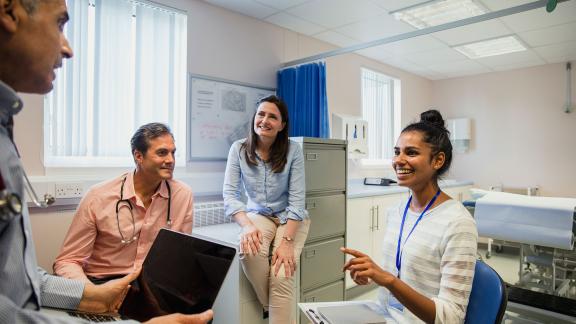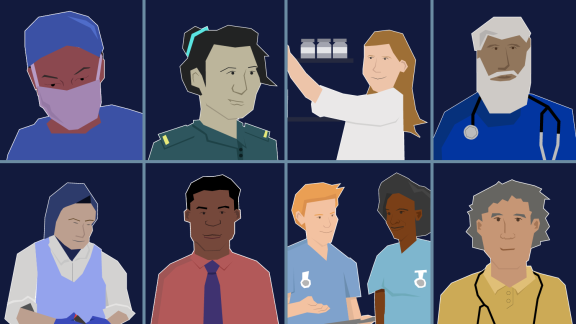Expanding placement capacity

One of the ambitions of the NHS Long Term Plan is to develop sustainable growth in the NHS workforce and scale up the number of people in learning. If employers are to meet this ambition and support the recruitment drive for roles in nursing, midwifery and the allied health professions, then placement capacity will need to increase, while maintaining the required quality and level of educational support.
Clinical placements are a pivotal element of healthcare education and from our discussions with employers, the ambition and motivation to meet the proposed increase in students is clear, however there is some apprehension about how additional capacity for placements can be generated.
Historically, the ability to take on learners for whom practice-based learning is a requirement of their programme has been limited by two main factors, the number of placements available to host them and having experienced staff who can teach and assess.
This page looks at ideas for employers to explore and links to resources that can help to increase their placement capacity.
Identifying your practice supervisors
The Nursing and Midwifery Council (NMC) standards for nurses implemented in January 2019 include the standards for student supervision and assessment, which provides an opportunity for employers to review the supervision models used for their students.
A significant change is the move away from the traditional method of mentoring to one that separates out the supervisor and assessor roles, where students can be supervised by an NMC registered nurse, midwife, nursing associate, or any other registered health and social care professional.
Joined-up approach
Increasing placement capacity cannot be achieved by employers alone. All stakeholders involved in the development of professionals need to work together to find ways of overcoming the barriers to expanding capacity. Having a group that includes employers, the higher education sector, local health and care providers and national bodies that comes together and shares preferences for how programmes are delivered, is more likely to come up with solutions that work for everyone.
At an employer level, managers also need to be involved. It is not enough to raise awareness about the necessity to increase capacity, managers need time to explore options that work for them and their teams, and identify what can be changed to overcome barriers and resistance.
Through partnerships with local Universities, Northumberland, Tyne and Wear NHS Foundation Trust has increased student numbers, in particular for their mental health and learning disabilities nursing programmes. To manage the increase in clinical placements and mentor support, the trust introduced a central mentor database aligned to ESR. This feeds into a dashboard that has enabled the trust to strengthen its governance of mandatory training, identify mentors that are no longer active and target areas for development. The trust also created two new roles; a practice educator support nurse and practice placement support co-ordinator, who support individual learners and help embed the programmes.
Diversity in placement options
To increase their capacity, some employers have begun to explore and change how, when and where placements are offered. For some organisations, this has required a change in organisational culture and staff mindsets.
Use of simulation and remote placement activity
The outbreak of COVID-19 saw a range of new approaches to placement activity that can be counted towards the programme delivery and still provide students with a rich experience. Given the benefits some of these ideas have brought, it is worth exploring whether they can be adopted permanently going forward.
There is also an increase in the development of blended learning programmes which incorporate a mix of training techniques. For example, delivered online either in a group or for individual to access when convenient. Some sessions could be ‘face to face’. Technology is also being explored that use virtual reality where students work through a series of tasks and skills tests.
Health Education England has published its National Strategic Vision for simulation and immersive technologies (PDF) for use in health and care that explores how high-quality, simulation-based programmes can be applied to help address system-wide challenges faced within the health and care sector.
The University of Portsmouth introduced on-campus simulation activities that counted towards placement hours and avoided putting additional pressure onto an already complex system.
During the early phase of the COVID-19 outbreak, some students were deployed into non-patient areas such as small peer groups, where they worked on projects, policy and research with universities. Feedback from these groups stated that this provided them with a better understanding of the bigger picture around their profession, and gave them fresh ideas and skills to take into clinical settings.
For first-year students who were not able to complete their placements, some universities brought forward some of the theory work normally taught in the year two. Those practice hours will be made up during the second year as less time can be spent in academic study.
Technology Enabled Care Services (TECS) such as telehealth, telecare, and self-care apps all involve delivering patient care where the patient is not in the same room as the clinician. TEC services could host students, either in a clinic with a practice educator, or at home delivering care either via a virtual platform or over the telephone. Putting students in these settings will also give them exposure to digital skills.
Remote consultation - providing access to online consultations and group case discussions outside the clinic environment. These have been used for occupational health, physiotherapy, and advanced practice clinics.
Offering support sessions online for students out on placements can provide an opportunity to keep in touch and enable them to air any concerns or worries.
Different models of supervision
In a move away from the traditional mentoring model many trusts are exploring different approaches to how they support their students and learners.
Coaching models
Introducing a coaching style approach to student supervision has enabled many trusts to increase their capacity. Under this approach students are directly involved in hands-on patient care and empowered to take a greater level of responsibility for their own self-directed learning.
Under the model students from different year groups work together as a team with support from a practice educator, or coach who is available to observe and supervise and ask ‘coaching’ questions that encourage the students to explain their practice and identify the learning. The approach has been used in different areas including: outpatients, children’s mental health units, midwifery, children’s nursing and community settings.
Hear from staff at James Paget University Hospitals NHS Foundation Trust about how they have used the CLiP (Collaborative Learning in Practice) coaching model to increase placement capacity in this podcast.
Find out more about different clinical placement supervision models.
Further information
National AHP virtual hub
Join the National AHP virtual hub on the Future NHS Collaboration Platform where you can engage with other employers on placement capacity topics.
Think placements differently webinar
Watch this think placements differently webinar by Dorset Healthcare University NHS Foundation Trust which explores how to expand AHP clinical placement capacity.
Think placements differently webinar summary:
- 9 minutes - summary of alternative models of supervision and placement delivery
- 24 minutes - Split placement 2 days research, 3 days clinical
- 35 mins - virtual placements
- 41 minutes - role emerging placements, introduced this role for the first time into Mental Health and Social Care
- 51 minutes - increasing placement capacity ideas
- 61 minutes - engaging teams in increasing placement capacity
- 1:10 - working collaboratively to increase capacity
- 1:15 - Q&A
Expanding placement capacity
Watch our webinar on expanding placement capacity where three employers discuss the approaches they have taken to expand placement capacity in their organisations and regions.
Using nurse degree apprenticeships webinar
In this webinar, Humber Teaching Hospitals NHS Foundation Trust explored new placement areas within the trust to increase capacity and offer high-quality learning.



